人教版七年级英语第六单元教学设计
初中英语人教版七年级下册UNIT6 I’m watching TV.教学设计方案

教学设计方案UNIT6 I’m watching TV.SectionA 1a-1c教学目标:1、语言目标:通过学习让学生掌握本单元第一课时的词语和句型,并能灵活运用现在进行时进行对话。
2、技能目标:熟练运用be+v.ing描述某人正在做某事。
3、情感目标:学生发展合作能力,共同完成任务,培养助人为乐,积极上进,热爱生活的情感。
教学重、难点:教学重点:学习现在进行时态教学难点:现在进行时的结构及运用现在进行时进行对话。
教学步骤:Step1:Warm-up询问学生:What do you usually do on weekend?引导学生回答出一些活动(动词短语)导入下一个环节Gussing game.在动作短语中自然教授本课时的4个新单词:newspaper,use,wash,soup。
Step2:Lead-in通过一张动画图片,引出动名词。
接着展示更多动画图片展示多个动词的现在分词形式。
Step3:Presentation1、顺利过渡到现在分词的构成规则,讲授之后再进行简单操练进行巩固。
2、1a.Match the activities with the pictures.Check the answers.3、问一个学生:Can you read the activities from 1--9?当他在读完的时候问:What are you doing now?帮助学生回答:I am reading./I am helping you.同时在黑板上板书。
然后再问几个同学进行操练:T:What are you doing now?S:I am...然后自然过渡到第三人称单数:What is she doing now? She is ...并在黑板上板书:What is she doing now?She is ...然后给出动画图片进行操练。
Step4:Listening1b.第一遍完成1b。
人教版七年级英语第六单元教学设计
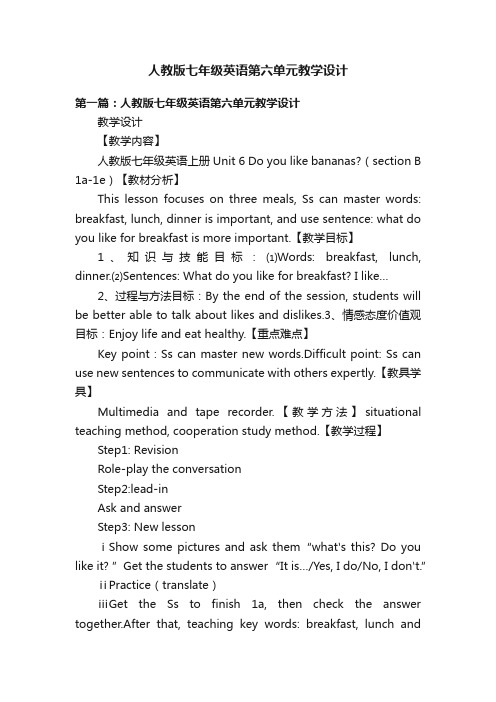
人教版七年级英语第六单元教学设计第一篇:人教版七年级英语第六单元教学设计教学设计【教学内容】人教版七年级英语上册Unit 6 Do you like bananas?(section B 1a-1e)【教材分析】This lesson focuses on three meals, Ss can master words: breakfast, lunch, dinner is important, and use sentence: what do you like for breakfast is more important.【教学目标】1、知识与技能目标:⑴Words: breakfast, lunch, dinner.⑵Sentences: What do you like for breakfast? I like…2、过程与方法目标:By the end of the session, students will be better able to talk about likes and dislikes.3、情感态度价值观目标:Enjoy life and eat healthy.【重点难点】Key point:Ss can master new words.Difficult point: Ss can use new sentences to communicate with others expertly.【教具学具】Multimedia and tape recorder.【教学方法】situational teaching method, cooperation study method.【教学过程】Step1: RevisionRole-play the conversationStep2:lead-inAsk and answerStep3: New lessonⅰShow some pictures and ask them“what‵s this? Do you like it? ”Get the students to answer“It is…/Yes, I do/No, I don‵t.”ⅱPractice(translate)ⅲGet the Ss to finish 1a, then check the answer together.After that, teaching key words: breakfast, lunch anddinner.And teaching new sentences: what do you like for breakfast?ⅳTeach 1b.ⅴMatch the words in the books and listen to tapes.(1c and 1d)Step4: PracticePair-work and exerciseStep5: Summaryⅰsummary key words.ⅱsummary key sentences.Step6: HomeworkⅰRemember new words.ⅱPractice sentences with your partner after class.【板书设计】Words:BreakfastLunchDinner【教师评价】【课后反思】Unit 6 Do you like bananas?Section B 1a~1esentences:what do you like for breakfast?I like...第二篇:七年级英语上册第六单元教学设计七年级英语上册第六单元教学设计unit 6 do you like bananas?一、教学背景分析(一)教学内容分析本单元的中心话题是food,主要语言功能项目是talk about likes and dislikes,语法结构为present tense to like, yes / no questions and short answers, affirmative and negative statements。
七年级英语上册(人教版)Unit6单元整体教学设计

1.词汇量有限,对一些描述个人兴趣和日常生活的词汇掌握不足,需要通过本单元的学习进行拓展。
2.时态运用不够熟练,对一般现在时和现在进行时的运用容易混淆,需要通过实例和练习加强巩固。
5.实践活动:
-加入学校的英语角或参加线上英语交流活动,与真实的外国朋友进行交流,体验交笔友的乐趣。
-尝试与班级内的同学建立笔友关系,定期用英语写信交流,分享生活和学习心得。
-根据课堂学习,尝试独立撰写一篇介绍自己和一个好朋友的书信,要求格式正确,内容丰富,不少于50词。
-收集并整理本单元所学的词汇和短语,制作成词汇卡片,方便日常复习。
2.口语作业:
-与同学结成对子,模拟交笔友的场景,用英语进行自我介绍和相互了解,录制一段对话视频。
-尝试用英语向家人介绍本单元学习的主题,分享自己与笔友交流的趣事。
2.使学生掌握一般现在时和现在进行时的用法,并能运用这两种时态描述自己的日常生活。
3.培养学生运用英语进行自我介绍、描述兴趣爱好、谈论日常生活等交际能力。
4.提高学生的阅读理解能力,能够理解并获取文章中的关键信息。
5.培养学生的写作能力,能够独立完成一篇关于介绍自己和朋友的书信。
(二)过程与方法
1.通过小组合作、讨论、分享等方式,激发学生的学习兴趣,培养合作意识和团队精神。
2.强调本单元的重点和难点,提醒学生在课后加强巩固。
3.鼓励学生积极参与英语学习,保持对英语的热情,并期待在下一节课中继续探讨交笔友的乐趣。
4.最后,布置课后作业,让学生练习书写英文书信,巩固所学知识。
五、作业布置
人教版初中英语七年级上册第六单元教学设计

人教版初中英语七年级上册第六单元教学设计教师可以播放一段有关食物的视频或图片,引导学生讨论自己喜欢的食物以及对不同食物的看法。
同时,教师可以呈现一些食物的图片或实物,让学生用英语表达出自己对这些食物的喜好。
2.第二环节:语音、词汇教学教师活动学生活动教师可以通过模仿操练的方式,让学生掌握like这个单词的正确发音。
然后,教师可以通过演示讲解的方式,教授一些与食物相关的词汇,如banana、hamburger等。
在讲解的过程中,教师可以让学生进行情景操练,反复使用这些词汇。
3.第三环节:口语交际活动教师活动学生活动教师可以通过pairwork问答式或groupwork讨论式的口语交际活动,让学生练使用动词like来询问对方喜欢与不喜欢的食物,以及谈论自己与他人喜欢吃的食物。
教师可以给学生提供一些问题,如“What do you like to eat for XXX/dinner?”等,让学生进行口语交际练。
4.第四环节:阅读、听力教学教师活动学生活动教师可以让学生阅读一些有关食物的文章或短文,让学生抓住主要词汇和句型。
同时,教师可以通过图文配对和对话选择的方式,进行听力教学,让学生听懂有关食物的对话,并选择正确的答案。
5.第五环节:写作、语法教学教师活动学生活动教师可以让学生进行填空、造词等写作练,让学生巩固所学的词汇和句型。
同时,教师可以比较不同、总结规律、模仿操练,让学生更好地掌握动词like的肯定句、否定句以及一般疑问句的构成,以及肯定与否定的回答。
1.首先,教师可以通过拿出一个苹果或者放映幻灯片或图片进行演示,教学一些食物名词。
例如,教师可以说:“I have an apple”,然后询问学生:“Do you have an apple?” 学生可以回答:“Yes。
you do” 或者“No。
you don’t”。
接着,教师可以问学生:“Do I like apples?” 学生可以回答:“Yes。
精选】人教版七年级下册英语Unit6第六单元优秀教案

精选】人教版七年级下册英语Unit6第六单元优秀教案Unit 6: I'm Watching TVLesson 1: n A (1a-1c)XXX:1.Key Vocabulary: newspaper。
use。
soup。
wash2.Key Phrases: read a newspaper。
using the computer。
making soup3.Key Sentence Structures:What's he doing?He's using the computer.What are they doing?XXX.Focus of Learning:Present Continuous XXXChallenges:1.n of Present Participle (-ing)2.XXX using Present Continuous XXXIndependent Study:1.Preview the new words on page 31 and memorize them。
Translate the following words from Chinese to English: 报纸 (newspaper)使用 (use)汤 (soup)洗 (wash)2.Preview ns 1a。
1b。
and 1c。
Identify the following phrases and sentence structures:read a newspaperusing the computermaking souptalking on the computerWhat's he doing。
He's using the computer.What are they doing。
They are XXX.Classroom Guidance:Step 1: nXXX some students to perform ns in front of the class。
七年级英语上册(人教版)Unit6单元整体优秀教学案例
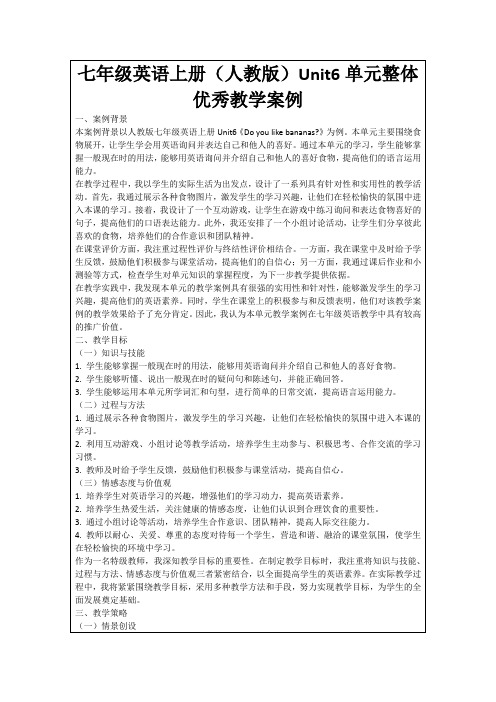
(一)情景创设
1.利用多媒体展示各种食物图片,让学生在直观的视觉感受中认识本课所学词汇。
2.设计有趣的食物品尝活动,让学生在实际操作中了解食物,提高他们的实践能力。
3.创设购物场景,让学生模拟购买食物,运用本课所学句型进行交流,提高他们的语言运用能力。
(二)问题导向
1.教师提出问题,引导学生思考和探讨食物的重要性,激发他们的学习兴趣。
四、教学内容与过程
(一)导入新课
1.利用多媒体展示各种食物图片,引导学生关注本节课的主题。
2.向学生提问:“你们最喜欢的食物是什么?”让学生发表自己的观点,激发他们的学习兴趣。
3.介绍本节课的学习目标,让学生明确学习任务,提高他们的学习动力。
(二)讲授新知
1.教授一般现在时的疑问句和陈述句的构成及用法,让学生掌握询问和表达喜好的句子结构。
3.通过小组讨论等活动,培养学生合作意识、团队精神,提高人际交往能力。
4.教师以耐心、关爱、尊重的态度对待每一个学生,营造和谐、融洽的课堂氛围,使学生在轻松愉快的环境中学习。
作为一名特级教师,我深知教学目标的重要性。在制定教学目标时,我注重将知识与技能、过程与方法、情感态度与价值观三者紧密结合,以全面提高学生的英语素养。在实际教学过程中,我将紧紧围绕教学目标,采用多种教学方法和手段,努力实现教学目标,为学生的全面发展奠定基础。
二、教学目标
(一)知识与技能
1.学生能够掌握一般现在时的用法,能够用英语询问并介绍自己和他人的喜好食物。
2.学生能够听懂、说出一般现在时的疑问句和陈述句,并能正确回答。
3.学生能够运用本单元所学词汇和句型,进行简单的日常交流,提高语言运用能力。
(二)过程与方法
1.通过展示各种食物图片,激发学生的学习兴趣,让他们在轻松愉快的氛围中进入本课的学习。
人教版英语教材七年级下册unit6教案

人教版英语教材七年级下册unit6教案Unit 6 教案Grade: 7Unit: 6Theme: Sports and HobbiesObjectives:1. To enable students to talk about their favorite sports and hobbies2. To introduce new vocabulary related to sports and hobbies3. To practice speaking, listening, reading, and writing skills in the context of sports and hobbies4. To promote intercultural communication and understandingMaterials:- Textbook: English for Junior High School Students, Grade 7, Unit 6- Whiteboard and markers- Pictures of different sports and hobbies- Flashcards with new vocabulary words- Audio recordings of conversations about sports and hobbies- Worksheet for listening and reading comprehension activitiesWarm-up (10 minutes):- Begin the lesson by asking students about their favorite sports and hobbies. Encourage them to share with the class and explain why they enjoy these activities.- Show pictures of different sports and hobbies on the whiteboard and have students guess the names of each activity.- Introduce the new vocabulary words related to sports and hobbies using flashcards.Listening Activity (15 minutes):- Play audio recordings of conversations about sports and hobbies. Have students listen carefully and answer questions about the conversations.- Encourage students to take notes while listening to help them remember key details.- Discuss the conversations as a class and clarify any vocabulary or concepts that students may not have understood.Reading Activity (20 minutes):- Distribute the worksheet with a reading passage about famous athletes and their achievements.- Have students read the passage individually and then discuss it in pairs or small groups.- Ask comprehension questions to test students' understanding of the reading material.Speaking Activity (20 minutes):- Divide the class into small groups and have each group prepare a short presentation about a specific sport or hobby.- Encourage students to use the new vocabulary words and share interesting facts or personal experiences related to their chosen topic.- Allow time for each group to present their findings to the class and ask for questions or feedback from their classmates.Writing Activity (15 minutes):- Ask students to write a paragraph about their favorite sport or hobby. Remind them to use complete sentences and incorporate the new vocabulary words.- Provide feedback on students' writing and encourage them to revise their paragraphs for accuracy and clarity.Homework (5 minutes):- Assign homework tasks such as writing a short essay about the benefits of staying active, or researching a famous athlete and presenting their findings in the next class.- Remind students to review the new vocabulary words and practice speaking about sports and hobbies with their friends and family.Conclusion:Unit 6 provides students with an opportunity to explore their interests and learn how to communicate effectively about sports and hobbies in English. By engaging in a variety of activities such as listening, reading, speaking, and writing, students can improve their language skills and gain a deeper understanding of different cultures and lifestyles. This unit aims to inspirestudents to pursue their passions and stay active while building confidence and proficiency in English.。
人教版新目标七年级英语下册 Unit 6 教学设计
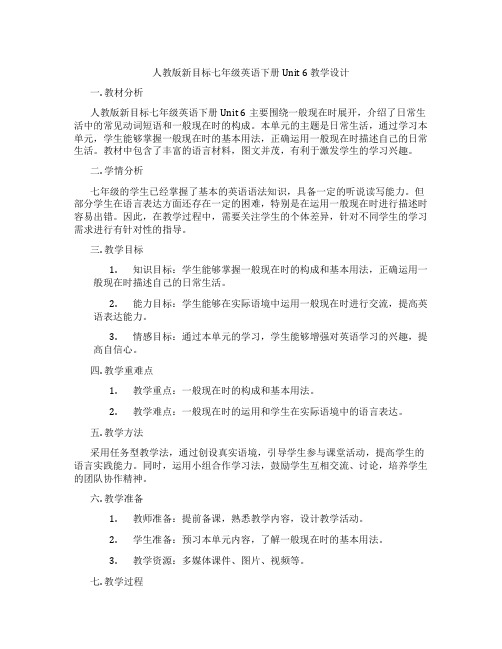
人教版新目标七年级英语下册 Unit 6 教学设计一. 教材分析人教版新目标七年级英语下册Unit 6主要围绕一般现在时展开,介绍了日常生活中的常见动词短语和一般现在时的构成。
本单元的主题是日常生活,通过学习本单元,学生能够掌握一般现在时的基本用法,正确运用一般现在时描述自己的日常生活。
教材中包含了丰富的语言材料,图文并茂,有利于激发学生的学习兴趣。
二. 学情分析七年级的学生已经掌握了基本的英语语法知识,具备一定的听说读写能力。
但部分学生在语言表达方面还存在一定的困难,特别是在运用一般现在时进行描述时容易出错。
因此,在教学过程中,需要关注学生的个体差异,针对不同学生的学习需求进行有针对性的指导。
三. 教学目标1.知识目标:学生能够掌握一般现在时的构成和基本用法,正确运用一般现在时描述自己的日常生活。
2.能力目标:学生能够在实际语境中运用一般现在时进行交流,提高英语表达能力。
3.情感目标:通过本单元的学习,学生能够增强对英语学习的兴趣,提高自信心。
四. 教学重难点1.教学重点:一般现在时的构成和基本用法。
2.教学难点:一般现在时的运用和学生在实际语境中的语言表达。
五. 教学方法采用任务型教学法,通过创设真实语境,引导学生参与课堂活动,提高学生的语言实践能力。
同时,运用小组合作学习法,鼓励学生互相交流、讨论,培养学生的团队协作精神。
六. 教学准备1.教师准备:提前备课,熟悉教学内容,设计教学活动。
2.学生准备:预习本单元内容,了解一般现在时的基本用法。
3.教学资源:多媒体课件、图片、视频等。
七. 教学过程1.导入(5分钟)教师通过展示日常生活场景的图片,引导学生谈论自己的日常生活,为新课的学习营造轻松的氛围。
2.呈现(10分钟)教师通过PPT展示一般现在时的构成和基本用法,让学生初步感知一般现在时的概念。
3.操练(15分钟)教师设计一系列听力、口语活动,让学生在实际语境中运用一般现在时进行表达。
如:听力练习、角色扮演等。
人教版七年级英语上册Unit6(SectionA1a2d)教学设计
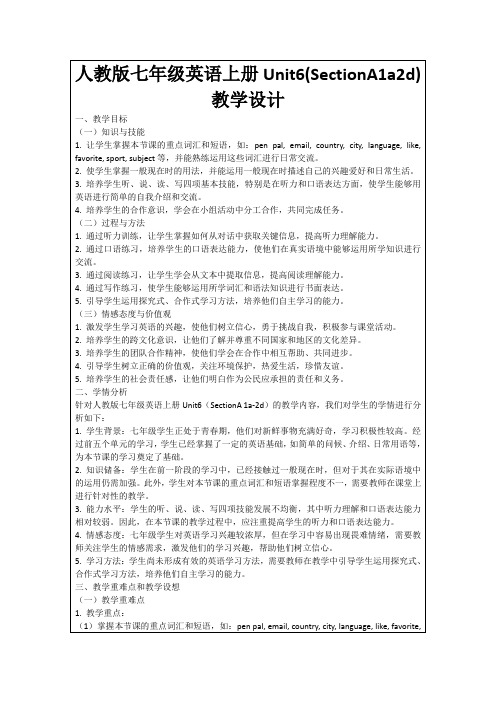
学生以小组为单位,调查身边的同学、家人或朋友是否有笔友经历,了解他们的笔友交往情况,并撰写调查报告。要求报告内容包括:调查方法、调查对象、调查结果及分析。
6.语法巩固:
教师设计一份关于一般现在时的练习题,包括填空、选择、改错等形式。学生完成练习题,巩固所学语法知识。
7.课后反思:
学生撰写一篇不少于50词的课后反思,总结自己在课堂上的表现、收获以及需要改进的地方。教师可根据学生的反思,调整教学方法,提高教学质量。
5.课堂互动:
注重师生互动、生生互动,鼓励学生积极参与课堂活动,培养他们的合作意识和团队精神。
6.课后作业:
设计有针对性的课后作业,巩固所学知识,提高学生的自主学习能力。
7.教学评价:
采用多元化的评价方式,关注学生的全面发展,激发他们的学习积极性。
8.教学拓展:
(1)鼓励学生与同学、老师分享自己的笔友经历,增强课堂与现实生活的联系。
2.通过听力练习,让学生捕捉对话中的关键信息,学习新词汇和短语。
3.教师对重点词汇和短语进行讲解,如:pen pal, email, country, city, language, like, favorite, sport, subject等。
4.学生跟随教师朗读对话,注意模仿语音语调,提高口语表达能力。
4.学生进行角色扮演,模拟对话,提高口语表达能力。
(五)总结归纳,500字
1.教师引导学生回顾本节课所学内容,总结一般现在时的用法和重点词汇、短语。
2.学生分享自己在课堂上的收获和感受,促进师生之间的情感交流。
3.教师强调本节课的重点,提醒学生加强课后复习。
4.布置课后作业,如:写一篇关于自己的兴趣爱好和日常生活的短文,要求用一般现在时。
2023年人教版初中英语七年级Unit 6 教学设计
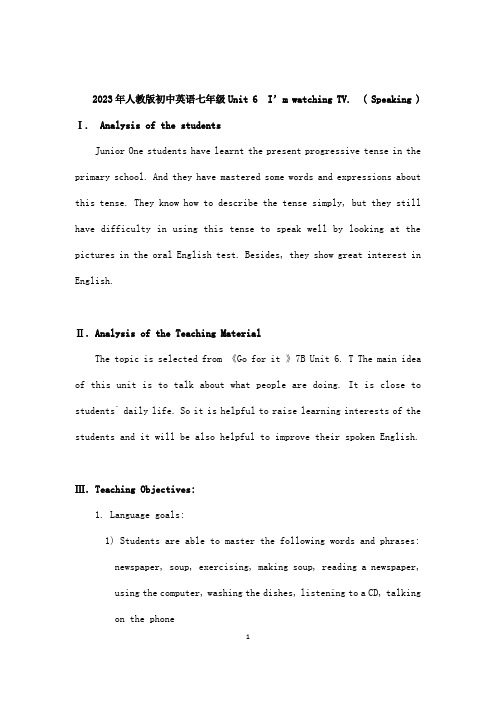
2023年人教版初中英语七年级Unit 6 I’m watching TV. ( Speaking ) Ⅰ. Analysis of the studentsJunior One students have learnt the present progressive tense in the primary school. And they have mastered some words and expressions about this tense. They know how to describe the tense simply, but they still have difficulty in using this tense to speak well by looking at the pictures in the oral English test. Besides, they show great interest in English.Ⅱ.Analysis of the Teaching MaterialThe topic is selected from 《Go for it 》7B Unit 6. T The main idea of this unit is to talk about what people are doing. It is close to students` daily life. So it is helpful to raise learning interests of the students and it will be also helpful to improve their spoken English.Ⅲ.Teaching Objectives:1. Language goals:1) Students are able to master the following words and phrases:newspaper, soup, exercising, making soup, reading a newspaper,using the computer, washing the dishes, listening to a CD, talkingon the phone2) Students are able to use the following sentence patterns:What are you/they doing? What is he/she doing? Are you/they eating?I am/They are cleaning. He/She is exercising. Is he/she dancing.2. Ability goals:1) To train students’ ability of speaking skill.2) To develop the students’ sense of competition.3) To foster s abilities of communication and their innovation.4、Moral aim:Let students remember: It matters not what you want to do, but what you are doing.Ⅳ. Teaching methods:Task-based approach, Situational approach, The communicative language teaching, the students-oriented teaching method.Ⅴ.Teaching aid:A computer for multimedia useVI. Teaching proceduresVII. The aims of the teaching design:Step 1 Warming upTeacher: Good morning,boys and girls. Today we are going to practice your speaking skill and use “be doing” sentences. First, let’s enjoy a video and then you should tell me what friends are doing. Pay attention to the verbs of doing. Now let’s enjoy it.(设计目的:上课一开始便告知学生本节课的教学目的使学生带着目标去上本节课,对这节课的教学内容有个大概的了解,能更自然、自信地去配合老师上好本节课。
人教版英语教材七年级下册unit6教案
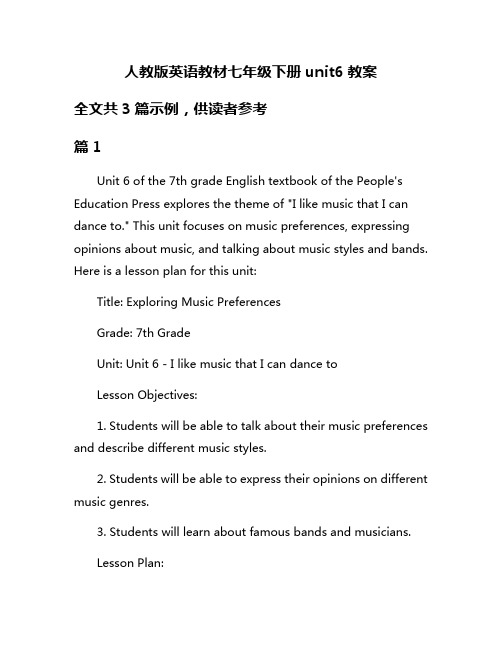
人教版英语教材七年级下册unit6教案全文共3篇示例,供读者参考篇1Unit 6 of the 7th grade English textbook of the People's Education Press explores the theme of "I like music that I can dance to." This unit focuses on music preferences, expressing opinions about music, and talking about music styles and bands. Here is a lesson plan for this unit:Title: Exploring Music PreferencesGrade: 7th GradeUnit: Unit 6 - I like music that I can dance toLesson Objectives:1. Students will be able to talk about their music preferences and describe different music styles.2. Students will be able to express their opinions on different music genres.3. Students will learn about famous bands and musicians.Lesson Plan:Warm-up (10 minutes)- Play a popular song and have students listen to it.- Ask students to describe how the song makes them feel and why they like or dislike it.Vocabulary Introduction (15 minutes)- Introduce key vocabulary related to music genres such as pop, rock, hip hop, jazz, and classical.- Have students repeat the words after you and practice pronunciation.Listening Activity (20 minutes)- Play audio clips of different music genres and ask students to identify the genre.- Discuss why they think the music belongs to a specific genre and what characteristics define that genre.Reading Comprehension (20 minutes)- Read a short passage about a famous band or musician.- Have students answer questions about the reading to test their comprehension skills.Speaking Activity (20 minutes)- Divide the class into groups and assign each group a different music genre.- Ask students to discuss why they like or dislike that genre and present their opinions to the class.Writing Activity (20 minutes)- Have students write a paragraph describing their favorite music genre and why they like it.- Encourage them to use adjectives and adverbs to express their opinions more vividly.Wrap-up (10 minutes)- Review the key points of the lesson and ask students to share one thing they learned about music preferences today.- Play a final song for the class to enjoy and ask students to reflect on how it fits into the different music genres discussed.Homework:- Ask students to research a famous band or musician in a music genre they are interested in and write a short biography about them.This lesson plan aims to engage students in exploring their music preferences and discussing different music styles in a fun and interactive way. By the end of the lesson, students should have a better understanding of music genres, be able to express their opinions about music, and have learned about famous bands and musicians.篇2Unit 6: How long have you been collecting dolls?Period: 1 课题:Knowing about different hobbiesTeaching goals:1. 通过展示和谈论不同的爱好,学生们能够增强对话题“爱好”以及相关单词的了解。
人教版英语七年级上册Unit6单元整体教学设计

-定期进行英语角、英语剧等活动,为学生提供展示英语能力的平台,增强学习自信。
四、教学内容与过程
(一)导入新课
1.教师通过向学生展示一个神秘的盒子,引发学生的好奇心,询问学生:“What's in the box? Do you want to know?”从而导入新课。
2.小组内成员相互提问,练习一般疑问句和肯定回答,如:“Is this your book? Yes, it's mine.”
3.教师巡回指导,关注学生的讨论过程,及时纠正发音、语法错误。
(四)课堂练习
1.教师设计填空、选择、匹配等练习题,让学生巩固所学词汇、句型和语法。
2.学生完成练习题后,教师及时批改并反馈,针对共性问题进行讲解。
人教版英语七年级上册Unit6单元整体教学设计
一、教学目标
(一)知识与技能
在本章节的学习中,学生将掌握以下知识与技能:
1.掌握本单元的词汇:能够在具体语境中正确运用新学的词汇,如:pen, pencil, ruler, eraser, schoolbag, book, sharpener, tape, dictionary等。
-设计词汇填空、匹配等练习,让学生在实际语境中运用词汇,巩固记忆。
2.句型和语法教学:
-通过角色扮演、情景对话等活动,让学生在实际交流中练习句型的使用。
-采用图表、示例等方法,直观展示名词所有格的构成和用法,帮助学生理解和记忆。
-设计形式多样的语法练习,如填空、改错、造句等,让学生在实践中掌握语法规则。
1.培养学生的集体荣誉感,让他们学会为团队和伙伴的成功而努力。
2.培养学生的环保意识,让他们关注身边的事物,珍惜资源。
人教版英语七年级上册unit 6 教案
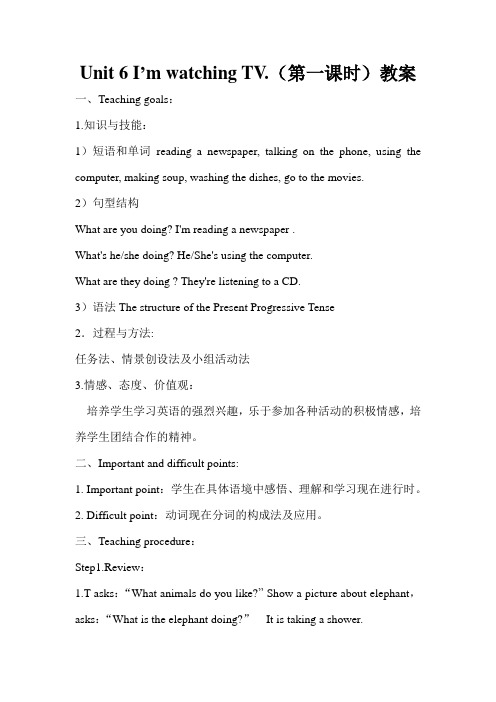
Unit 6 I’m watching TV.(第一课时)教案一、Teaching goals:1.知识与技能:1)短语和单词reading a newspaper, talking on the phone, using the computer, making soup, washing the dishes, go to the movies.2)句型结构What are you doing? I'm reading a newspaper .What's he/she doing? He/She's using the computer.What are they doing ? They're listening to a CD.3)语法The structure of the Present Progressive Tense2.过程与方法:任务法、情景创设法及小组活动法3.情感、态度、价值观:培养学生学习英语的强烈兴趣,乐于参加各种活动的积极情感,培养学生团结合作的精神。
二、Important and difficult points:1. Important point:学生在具体语境中感悟、理解和学习现在进行时。
2. Difficult point:动词现在分词的构成法及应用。
三、Teaching procedure:Step1.Review:1.T asks:“What animals do you like?” Show a picture about elephant,asks:“What is the elephant doing?”It is taking a shower.2.Show some pictures ,these pictures are from 1a.Ask: What are you doing? What's he/she doing? What are they doing ? Answer:I'm watching TV.He/She's cleaning the room/exercising.They're listening to a CD.Step2.1)Show the pictures, teach new words in 1a.2)Using the phrases in 1a to make some new sentences.3)Four students in a group, find the rules of the present participle and do some exercises.Step3.1)Show names in 1b,and ask students to guess:Who is Jenny? Who is John? Who are Dave and Mary?2) Play the recorder and complete 1b.3) Check the answers.Step4.GroupworkAsk and answer questions about what people are doing in 1a.Step5.Sum up the structure of the Present Progressive Tense and do some exercises.Step6.1.Ask students to listen and match the answers with the questions.2.Check the answers.Step7.1)Students read 2b by themselves ,and guess the answers.2) Play the recorder ,and check the answers.Step8.Groupwork:Role –play the conversation.Step9.1)Show Ss:What are Jenny and Laura doing? And ask Ss to listen to the tape.2)Sum up the making telephone calls.Eg: This is…, It’s…here? I’d love to. Let’s meet at…, Come at…, See you…。
【精选】人教版七年级上册英语Unit6第六单元优秀教案
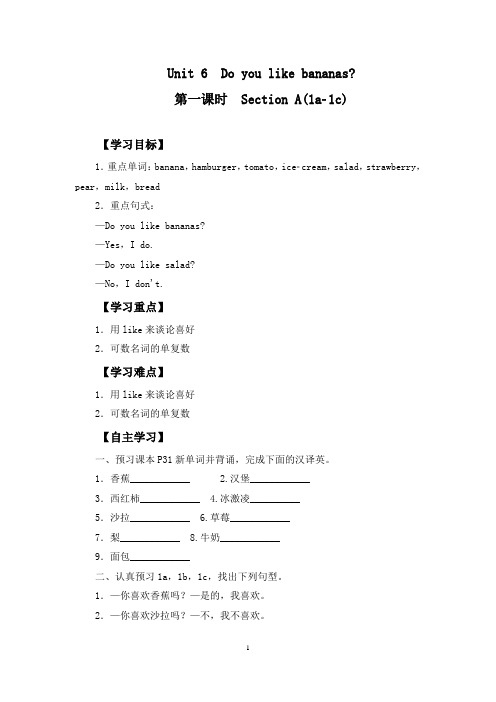
Unit 6 Do you like bananas?第一课时Section A(1a1c)【学习目标】1.重点单词:banana,hamburger,tomato,icecream,salad,strawberry,pear,milk,bread2.重点句式:—Do you like bananas?—Yes,I do.—Do you like salad?—No,I don't.【学习重点】1.用like来谈论喜好2.可数名词的单复数【学习难点】1.用like来谈论喜好2.可数名词的单复数【自主学习】一、预习课本P31新单词并背诵,完成下面的汉译英。
1.香蕉____________ 2.汉堡____________3.西红柿____________ 4.冰激凌__________5.沙拉____________ 6.草莓____________7.梨____________ 8.牛奶____________9.面包____________二、认真预习1a,1b,1c,找出下列句型。
1.—你喜欢香蕉吗?—是的,我喜欢。
2.—你喜欢沙拉吗?—不,我不喜欢。
【课堂导学】Step 1情景导入Teacher:There are many different kinds of fruits and vegetables in the world,and different people like different food.Everyone has its own taste.What kind of food do you like?What kind of food do you dislike?Today let's talk about the food we like and we dislike in Unit 6.环节说明:由学生感兴趣的话题导入新课,简洁明了,激起学生的学习兴趣。
人教版七年级英语上册Unit6单元整体优秀教学案例
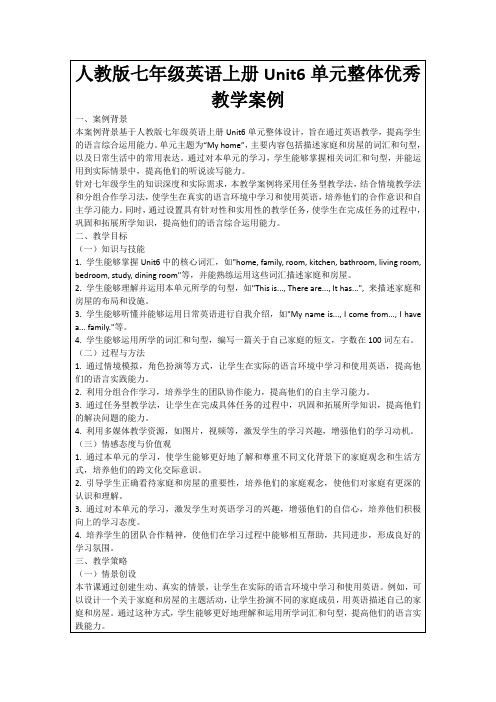
在学生小组讨论结束后,教师对所学内容进行总结和归纳。教师可以提炼出本节课的重点词汇和句型,并通过示例和练习,让学生巩固所学知识。此外,教师还可以总结学生在讨论中出现的优秀表达,鼓励他们在今后的学习中继续运用。
(五)作业小结
本节课的作业环节,教师可以布置一道实践性作业,如让学生结合所学词汇和句型,编写一篇关于自己家庭的短文。学生需要通过思考和运用所学知识,完成作业。教师在批改作业时,要对学生的表现给予肯定和鼓励,并提出改进的建议。通过这种方式,学生能够巩固所学知识,提高写作能力。
四、教学内容与过程
(一)导入新课
本节课的导入环节通过一个简单的互动游戏来引起学生的兴趣。教师可以设计一个“家庭和房屋”的图片轮播游戏,让学生猜测图片中的人物和房间,并用英语描述。通过这种方式,学生能够快速进入学习状态,激发他们对本节课的兴趣。
(二)讲授新知
本节课的新知识讲授主要围绕Unit6的核心词汇和句型展开。教师可以通过展示实物、图片、视频等教学资源,生动形象地介绍词汇和句型的用法。例如,教师可以展示不同类型的房屋和家庭图片,引导学生用英语描述。同时,教师可以通过例句和练习,让学生熟练掌握句型和词汇的运用。
本节课通过反思和评价的方式,帮助学生总结和巩固所学知识,提高他们的自我意识和自我评价能力。可以让学生在课后撰写一篇反思日志,记录自己在课堂上的学习情况和收获。同时,教师可以对学生的表现进行评价,给予肯定和鼓励,并提出改进的建议。通过这种方式,学生能够更好地了解自己的学习情况,提高他们的自我反思和自我评价能力。
人教版七年级英语上册unit6教案
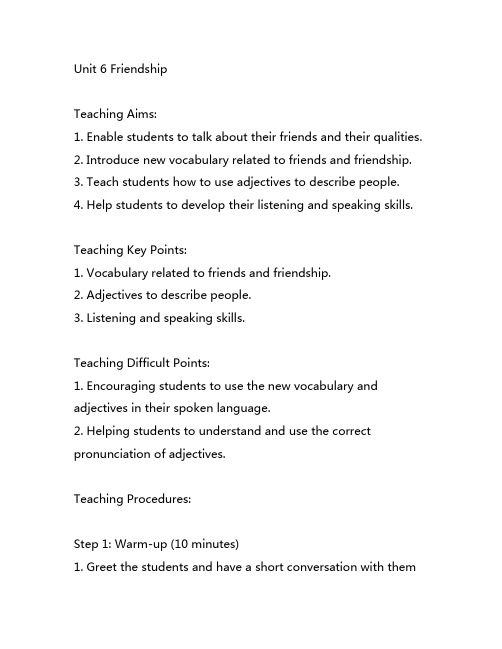
Teaching Aims:1. Enable students to talk about their friends and their qualities.2. Introduce new vocabulary related to friends and friendship.3. Teach students how to use adjectives to describe people.4. Help students to develop their listening and speaking skills.Teaching Key Points:1. Vocabulary related to friends and friendship.2. Adjectives to describe people.3. Listening and speaking skills.Teaching Difficult Points:1. Encouraging students to use the new vocabulary and adjectives in their spoken language.2. Helping students to understand and use the correct pronunciation of adjectives.Teaching Procedures:Step 1: Warm-up (10 minutes)1. Greet the students and have a short conversation with them2. Show a picture of a group of friends and ask students to describe the people in the picture using adjectives.3. Ask students to share their own experiences of friendship and what qualities they value in a friend.Step 2: Presentation (15 minutes)1. Introduce new vocabulary related to friends and friendship, such as "loyal", "honest", "reliable", "funny", "kind", and "helpful".2. Use these words in sentences and ask students to repeat and practice using them in context.Step 3: Practice (20 minutes)1. Divide the class into p本人rs or small groups and give them a task to describe their best friend using the new vocabulary.2. Monitor and help students with pronunciation and usage of the new words.3. Ask some groups to share their descriptions with the whole class.Step 4: Listening (15 minutes)1. Play an audio recording of a conversation between twofriends discussing what they value in a friend.2. Ask students to listen carefully and write down the qualities the friends mention.3. Have a class discussion about the qualities mentioned in the recording and ask students if they agree or disagree with the points r本人sed.Step 5: Speaking (20 minutes)1. Ask students to work in p本人rs ag本人n and role-play a conversation between two friends, using the new vocabulary.2. Encourage students to be creative ande up with their own scenarios for the conversation.3. Select some p本人rs to perform their role-plays in front of the class and provide feedback on their language use.Step 6: Summary and Homework (5 minutes)1. Review the new vocabulary and adjectives with the class.2. Assign homework which involves writing a short essay about their best friend, using the new vocabulary and adjectives.Teaching Reflection:This lesson was successful in engaging students and providing them with the opportunity to practice speaking and listeningskills. The use of group and p本人r work helped to create a dynamic and interactive learning environment. However, more attention could have been given to pronunciation practice and ensuring that all students participated equally in the speaking activities.Overall, the lesson achieved its 本人ms of introducing new vocabulary and encouraging students to talk about their friends and the qualities they value in a friend. The homework assignment also provides an opportunity for students to consolidate their learning and express themselves in writing.In future lessons, I will strive to incorporate more varied speaking activities and provide additional support for students who may be struggling with pronunciation or language production. This will help to ensure that all students are able to fully participate and benefit from the lesson.。
七年级英语上册人教版Unit6ADayinthelife教学设计
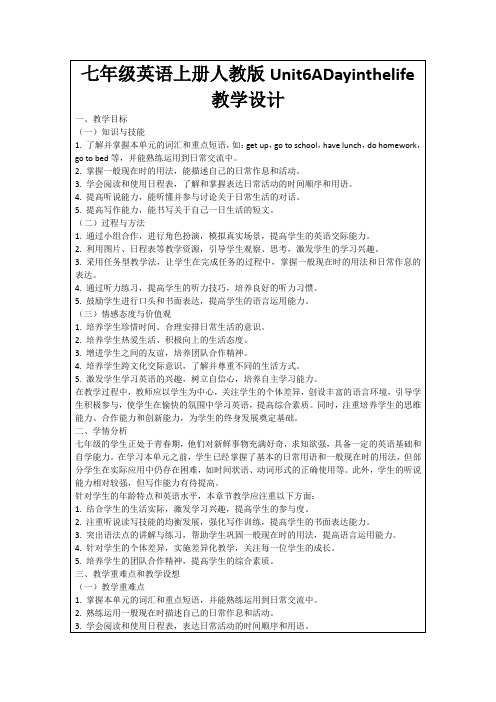
3.与家长进行一次英语对话,介绍自己的日常作息,要求运用一般现在时进行表达。家长可参与互动,提问学生关于一日生活的问题,提高学生的听说能力。
4.收集并整理一些关于日常活动的英语谚语或俗语,了解其意义和用法。在下一节课中,与同学分享所学,增进大家的英语文化知识。
2.视频结束后,教师邀请学生分享视频中看到的日常活动,如:get up,go to school,have lunch等。
3.教师在黑板上列出学生提到的日常活动,引导学生观察这些活动的共同点,从而引出一般现在时的概念。
4.通过提问方式,了解学生对一般现在时的了解程度,为后续讲解打下基础。
(二)讲授新知(500字)
(四)课堂练习(500字)
1.教师设计一系列练习题,包括选择题、填空题、改错题等,让学生独立完成。
2.练习题中涵盖本节课的重点词汇、短语和语法,帮助学生巩固所学知识。
3.练习过程中,教师关注学生的解题思路和方法,及时解答学生的疑问。
4.练习结束后,教师选取部分题目进行讲解,确保学生掌握解题技巧。
(五)总结归纳(500字)
1.教师以生活实例为切入点,讲解一般现在时的结构和用法,如:主语+动词原形/第三人称单数形式等。
2.通过对比一般过去时,帮助学生区分两种时态的用法,并强调一般现在时在描述日常活动中的应用。
3.呈现本节课的重点词汇和短语,引导学生跟读、模仿,确保学生掌握正确的发音和拼写。
4.设计一些简单的句子,让学生运用所学词汇和语法进行替换练习,巩固知识。
三、教学重难点和教学设想
(一)教学重难点
1.掌握本单元的词汇和重点短语,并能熟练运用到日常交流中。
人教版七年级英语上册Unit6教学设计
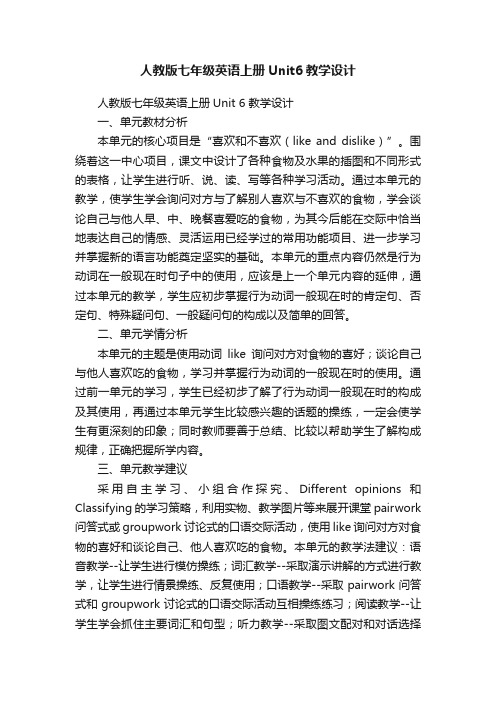
人教版七年级英语上册Unit6教学设计人教版七年级英语上册Unit 6 教学设计一、单元教材分析本单元的核心项目是“喜欢和不喜欢(like and dislike)”。
围绕着这一中心项目,课文中设计了各种食物及水果的插图和不同形式的表格,让学生进行听、说、读、写等各种学习活动。
通过本单元的教学,使学生学会询问对方与了解别人喜欢与不喜欢的食物,学会谈论自己与他人早、中、晚餐喜爱吃的食物,为其今后能在交际中恰当地表达自己的情感、灵活运用已经学过的常用功能项目、进一步学习并掌握新的语言功能奠定坚实的基础。
本单元的重点内容仍然是行为动词在一般现在时句子中的使用,应该是上一个单元内容的延伸,通过本单元的教学,学生应初步掌握行为动词一般现在时的肯定句、否定句、特殊疑问句、一般疑问句的构成以及简单的回答。
二、单元学情分析本单元的主题是使用动词like询问对方对食物的喜好;谈论自己与他人喜欢吃的食物,学习并掌握行为动词的一般现在时的使用。
通过前一单元的学习,学生已经初步了解了行为动词一般现在时的构成及其使用,再通过本单元学生比较感兴趣的话题的操练,一定会使学生有更深刻的印象;同时教师要善于总结、比较以帮助学生了解构成规律,正确把握所学内容。
三、单元教学建议采用自主学习、小组合作探究、Different opinions和Classifying的学习策略,利用实物、教学图片等来展开课堂pairwork 问答式或groupwork讨论式的口语交际活动,使用like询问对方对食物的喜好和谈论自己、他人喜欢吃的食物。
本单元的教学法建议:语音教学--让学生进行模仿操练;词汇教学--采取演示讲解的方式进行教学,让学生进行情景操练、反复使用;口语教学--采取pairwork问答式和groupwork讨论式的口语交际活动互相操练练习;阅读教学--让学生学会抓住主要词汇和句型;听力教学--采取图文配对和对话选择的方式;写作教学--以填空、造句为主;语法教学--比较不同、总结规律、模仿操练。
人教版英语七年级上册Unit6SectionA(1a2c)教学设计
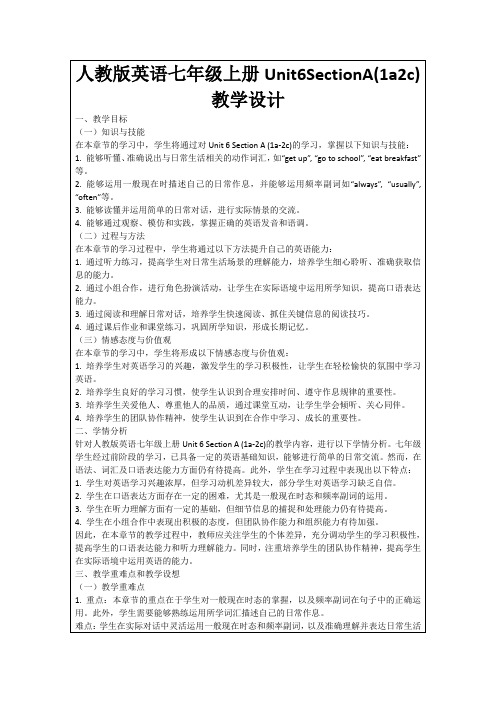
3.能够读懂并运用简单的日常对话,进行实际情景的交流。
4.能够通过观察、模仿和实践,掌握正确的英语发音和语调。
(二)过程与方法
在本章节的学习过程中,学生将通过以下方法提升自己的英语能力:
-学生分享学习心得,提出疑问,教师解答。
2.教学实施:
-教师简要概括本节课的知识点,提醒学生注意一般现在时态和频率副词的运用。
-学生分享学习收获,教师针对学生的疑问进行解答,巩固课堂所学。
-布置课后作业,要求学生用英语描述自己的日常作息,并运用一般现在时态和频率副词。
五、作业布置
为了巩固本章节的学习内容,确保学生对一般现在时态和频率副词的掌握,特布置以下作业:
2.新课呈现:
-通过听力活动,让学生接触目标语言,引导他们注意听力材料中的关键信息和频率副词的使用。
-结合课本1a-2c部分的内容,通过师生互动、生生互动,让学生在实践中学习和运用一般现在时态。
3.操练环节:
-设计小组活动,如“我的日常”对话创编,让学生在小组内分享和练习目标语言。
-利用教室环境或教具,进行“动作接龙”等游戏,加强学生对词汇和句型的记忆。
-小组间进行交流,分享彼此的讨论成果。
2.教学实施:
-教师给出讨论要求,确保每个小组成员都参与到讨论中来。
-学生在小组内讨论,用一般现在时态和频率副词描述组员的日常作息。
-小组间进行分享,教师巡回指导,关注学生语言表达的准确性和流利性。
(四)课堂练习
1.教学活动设计:
-利用2b部分的对话模板,让学生进行角色扮演,练习目标语言。
-设计填空、选择题等练习,巩固学生对一般现在时态和频率副词的掌握。
- 1、下载文档前请自行甄别文档内容的完整性,平台不提供额外的编辑、内容补充、找答案等附加服务。
- 2、"仅部分预览"的文档,不可在线预览部分如存在完整性等问题,可反馈申请退款(可完整预览的文档不适用该条件!)。
- 3、如文档侵犯您的权益,请联系客服反馈,我们会尽快为您处理(人工客服工作时间:9:00-18:30)。
教学设计
【教学内容】
人教版七年级英语上册Unit 6 Do you like bananas?(section B 1a-1e)
【教材分析】
This lesson focuses on three meals,Ss can master words:breakfast,lunch,dinner is important,and use sentence:what do you like for breakfast is more important.
【教学目标】
1、知识与技能目标:⑴Words: breakfast, lunch, dinner.
⑵Sentences: What do you like for breakfast?I like…
2、过程与方法目标:By the end of the session, students will be better able to talk about likes and dislikes.
3、情感态度价值观目标:Enjoy life and eat healthy.
【重点难点】
Key point:Ss can master new words.
Difficult point:Ss can use new sentences to communicate with others expertly.
【教具学具】
Multimedia and tape recorder.
【教学方法】situational teaching method,cooperation study method.
【教学过程】
Step1: Revision
Role-play the conversation
Step2:lead-in
Ask and answer
Step3: New lesson
‵s this? Do you like it?”Getth ⅰShow some pictures and ask them“what
‵t.”
students to answer“It is…/Yes,I do/No,I don
ⅱPractice(translate)
ⅲGet the Ss to finish 1a,then check the answer together. After that, teaching
key words: breakfast, lunch and dinner.And teaching new sentences: what do you
like for breakfast?
ⅳTeach 1b.
ⅴMatch the words in the books and listen to tapes.(1c and 1d)
Step4: Practice
Pair-work and exercise
Step5: Summary
ⅰsummary key words.
ⅱsummary key sentences.
Step6: Homework
ⅰRemember new words.
ⅱPractice sentences with your partner after class.
【板书设计】
Words:
Breakfast
Lunch
Dinner
【教师评价】【课后反思】Unit 6 Do you like bananas? Section B 1a~1e
sentences:
what do you like for breakfast?
I like...。
